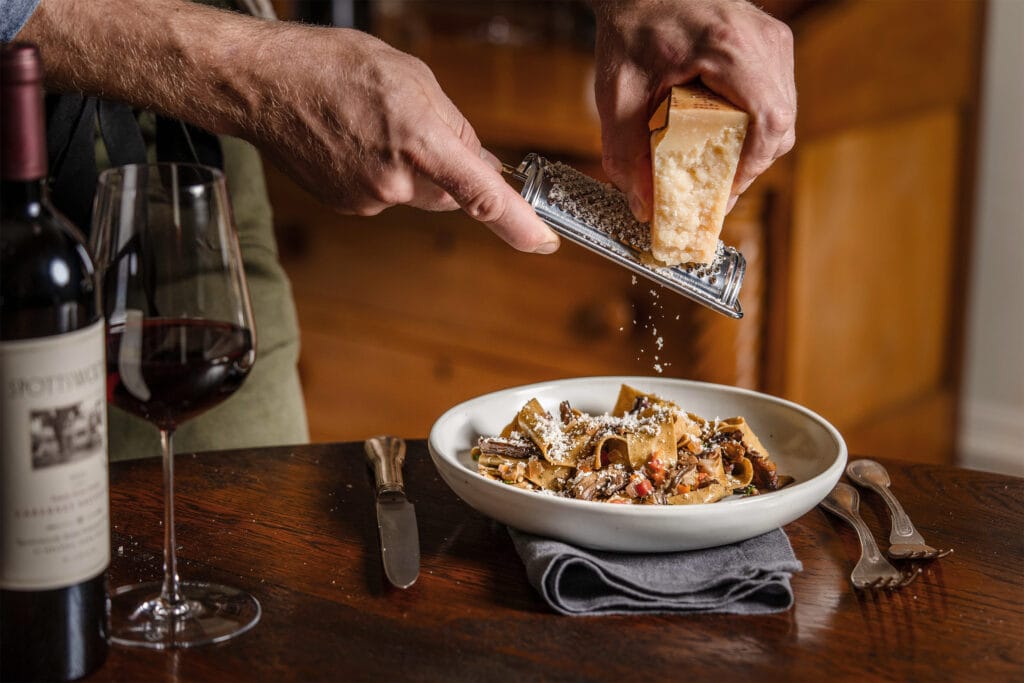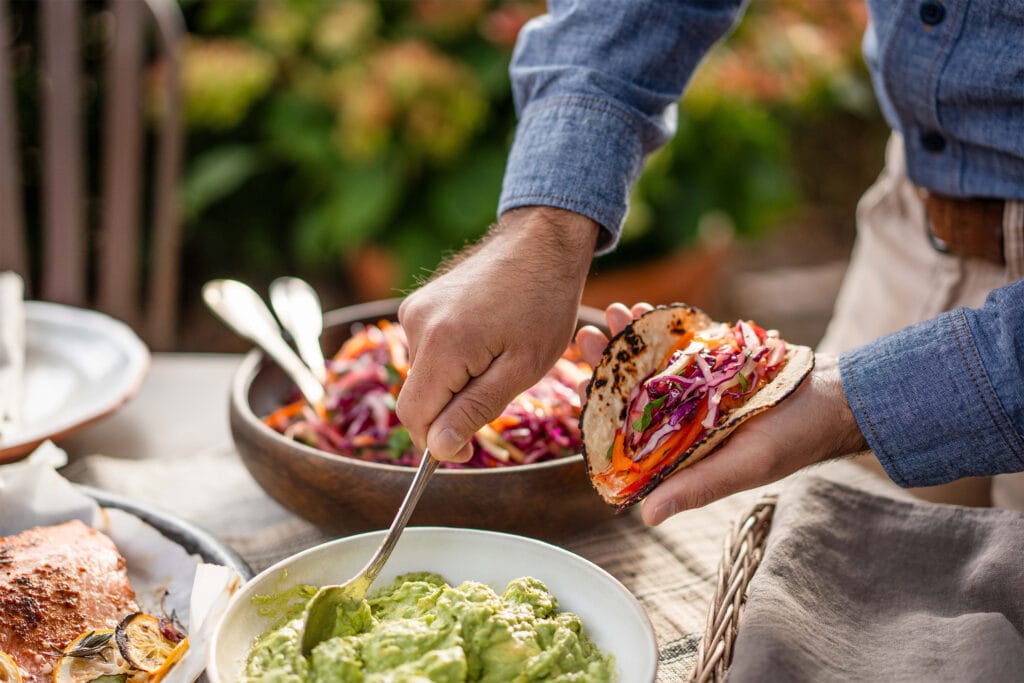Oysters with Cucumber and Meyer Lemon Mignonette
A sustainable choice paired with our Sauvignon Blanc
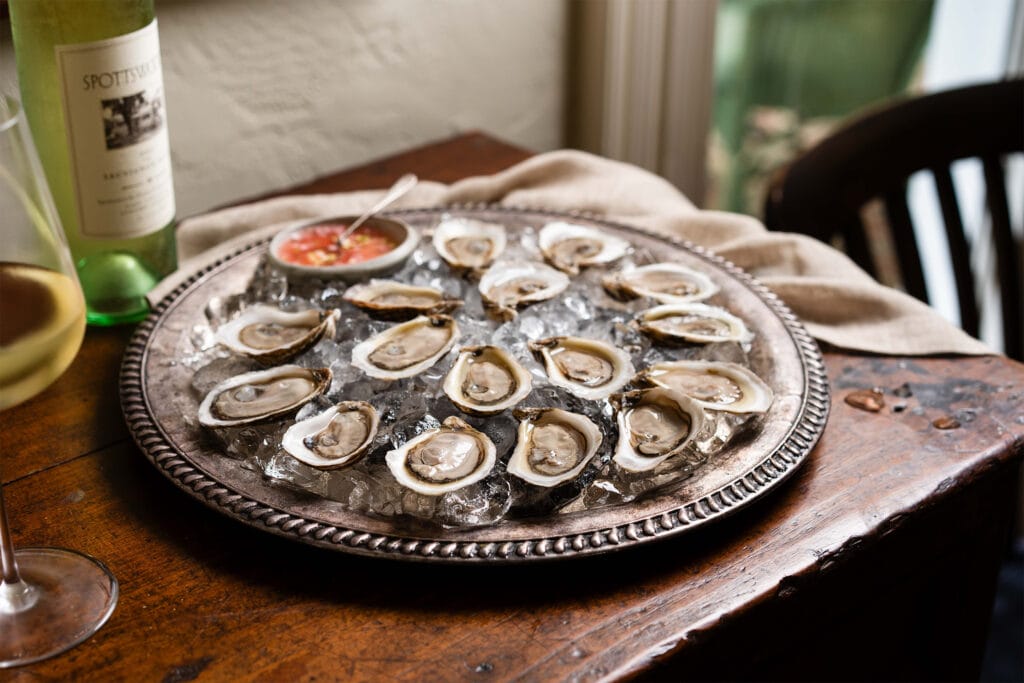
We love oysters paired with our Sauvignon Blanc and regularly serve them at Spottswoode gatherings. Besides being delicious, oysters are nutritionally dense and one of the most sustainable sources of protein available. Not only are they largely farmed in systems that respect the surrounding environment, but they can actually regenerate the ecology of the ocean by filtering up to 50 gallons of ocean water every day. Eating oysters helps support the work of dedicated oyster farmers and their families, and moves the needle on mitigating climate change since their shells sequester atmospheric carbon dioxide. Chef Gary’s simple mignonette sauce of cucumber and Meyer lemon spooned over a chilled oyster is a lovely foil for the minerality and balanced acidity of our Sauvignon Blanc – an elegant starter for an evening with friends or family.
Serves 3 – 6
For the Cucumber & Meyer Lemon Mignonette:
- 2 shallots, peeled
- ¾ cup white wine or champagne vinegar
- 1 small cucumber, peeled
- 2 ripe Meyer lemons, washed
- Freshly cracked black pepper
For the Oysters:
- 2-3 dozen oysters, shucked and cleaned
- Crushed ice or rock salt
We humans have sustained ourselves on oysters for millennia. There’s archeological evidence showing that indigenous peoples all over the world have been eating oysters for thousands of years. Ancient Romans tended oyster beds in the Italian peninsula and in Britain for export to Rome. Coastal cultures have thrived in symbiosis with oysters, creating an ongoing relationship to this species held deep in our history and traditions. Oysters should be approached with reverence but also with gusto, as they are a prized delicacy of the sea. A poorly shucked oyster is simply a wasted opportunity to experience one of the natural wonders of the gastronomic world. By understanding a little oyster anatomy and the proper method for shucking an oyster, you can help ensure a delicious experience for you and your guests.
When considering an oyster, orienting yourself is key. The “flat” side is up and the “cupped” side is down. The meat is held in the cupped or “bottom” shell along with a splash of seawater. The more rounded end is called the lip or bill – this is the end of the oyster you slurp from. Opposite the lip is the tapered hinge where the two shells meet – this is where you’ll pry open the oyster. Inside the bottom shell you’ll find a lovely teardrop of white flesh called the belly surrounded by a pearl gray skirt flaring toward the lip. This is all deliciously edible. Avoid puncturing the belly, as this holds the precious oyster liquor.
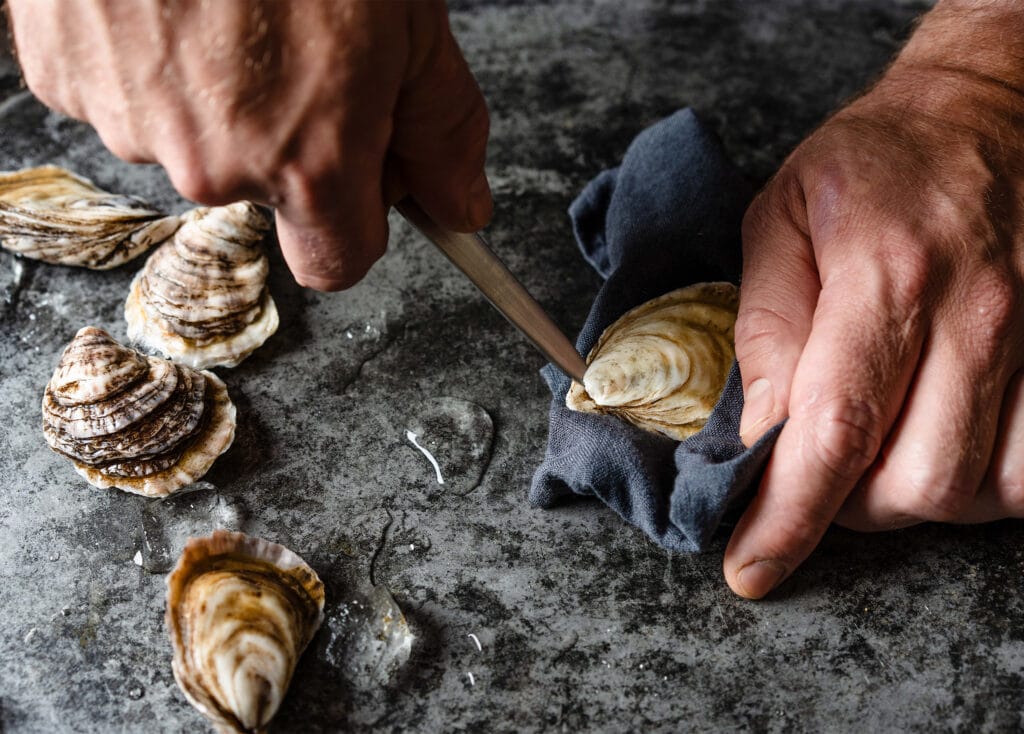
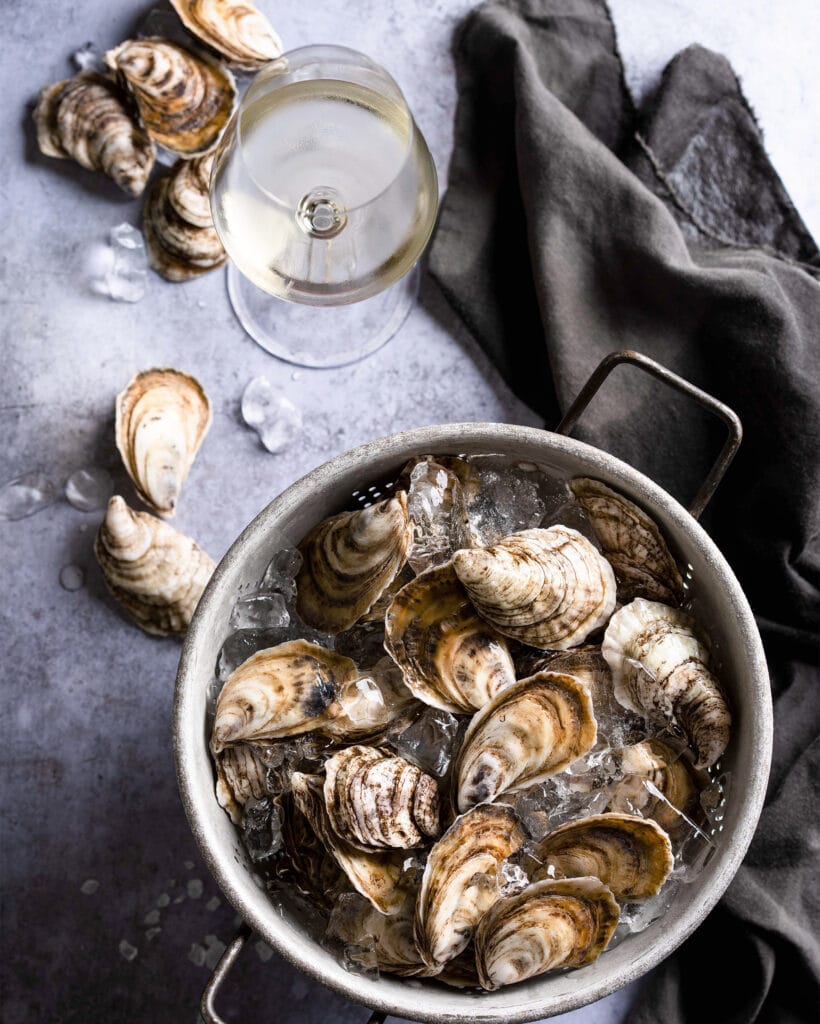
Selection, Preparation, and Supplies:
- The rule of thumb when selecting oysters is to find a busy fish market and ask which oysters are the freshest. Ideally, you’ll come home with a bag of extra small to medium-small oysters with relatively clean shells. My favorite varieties available in Northern California are Marin Miyagi, Kumamoto, and Sweetwater, but equally delicious are Beausoleil from New Brunswick, Pacific (especially those from Willapa Bay, Washington), and Kusshi from British Columbia. But again, trust your fishmonger and go with what looks the most appealing.
- Be sure to transport the oysters in an ice chest with plenty of crushed ice supplied by the fish market. Once you get them home, give them a gentle scrub with a stiff brush and rinse them well in very cold water. Keep your cleaned oysters on the crushed ice in the refrigerator or back in the ice chest until you’re ready to start shucking.
- Get yourself a kitchen towel, a tray of crushed ice or rock salt, and an oyster knife. Do not use a kitchen knife. The ideal tool looks like a dull round-tipped metal shank with a handle. If your fishmonger is worth their salt, they’ll have some for sale. The term “oyster knife” can be misleading to the uninitiated and has led to more than one trip to the emergency room.
Shucking:
- Fold the kitchen towel over itself and lay it on the counter or your cutting board. Set the oyster flat side up on the towel, with the hinge facing you. Fold the towel over the oyster to hold it in place, keeping the hinge exposed and your non-knife hand protected.
- Gently but firmly wriggle the tip of the knife into the hinge. Think about it like twisting the tip of the knife into the hinge as you would a key and “unlocking” it. You’ll feel the hinge start to give way as you slowly twist the tip of the knife back and forth. The ligament will pop and the shells will begin to separate. Slide the tip in another centimeter or two and rotate the blade to tilt the top shell up.
- Slide the knife along the interior surface of the top shell and separate the abductor muscle. Keep the oyster level while doing this to retain as much liquid inside as possible. Pull the top shell free and discard it.
- Wipe your knife clean on the towel. Coming from the lip side, run the tip of the knife along the surface of the bottom shell and separate the other side of the abductor beneath the oyster. The oyster should now freely slide around in the shell.
Success! You’ve shucked an oyster, but your work is not done. Next, smell the oyster. It should smell clean, minerally, and fresh like an ocean breeze; if it doesn’t, discard it. (Almost every batch of oysters has some rejects, so buy extra.) The only thing left to do before garnishing the oyster is to wipe away any grit or mud left on the lip. Using your thumb or the tip of your oyster knife, slide out any pieces of shell or debris and you’re ready to go.
The Mignonette:
- Cut shallots into ⅛-inch dice to make about ⅓ cup.
- In a small bowl, cover the diced shallots with the vinegar to macerate for at least 15 minutes.
- Cut ⅛-inch-thick slices off the sides of your cucumber, leaving the core of seeds behind. Discard the seeds. Cut the cucumber slices into long ⅛-inch-wide strips. Then cut those strips into ⅛-inch dice to make about ½ cup of cucumber. Add this to your shallot mixture.
- Holding the stem end of one Meyer lemon facing up, cut the sides off vertically, leaving you with a center section and two “cheeks.” Squeeze the center section through a strainer into the shallot-cucumber mixture. Finely slice the cheeks into ⅛-inch strips and then into ⅛-inch dice. Mix these into the bowl along with 7 or 8 grinds of black pepper.
- Cut the remaining Meyer lemon into wedges.
- Arrange the oysters on a tray of crushed ice or rock salt and serve with a bowl of the mignonette and Meyer lemon wedges. Let everyone garnish as they see fit. Bon appetit!
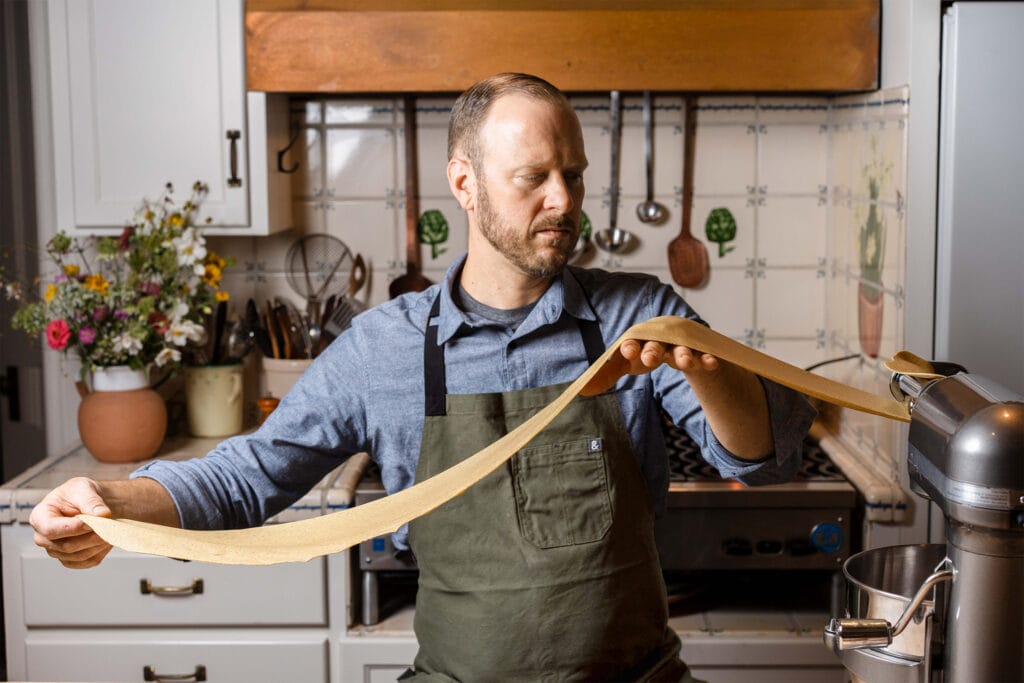
Gary Podesto is a cook at Chez Panisse Restaurant in Berkeley, California and is the Chief Culinary Collaborator for the Climate Farm School. His work aims to revitalize the ritual of gathering around the hearth and table while promoting the values of edible education and regenerative agriculture. Learn more at garypodesto.net.



